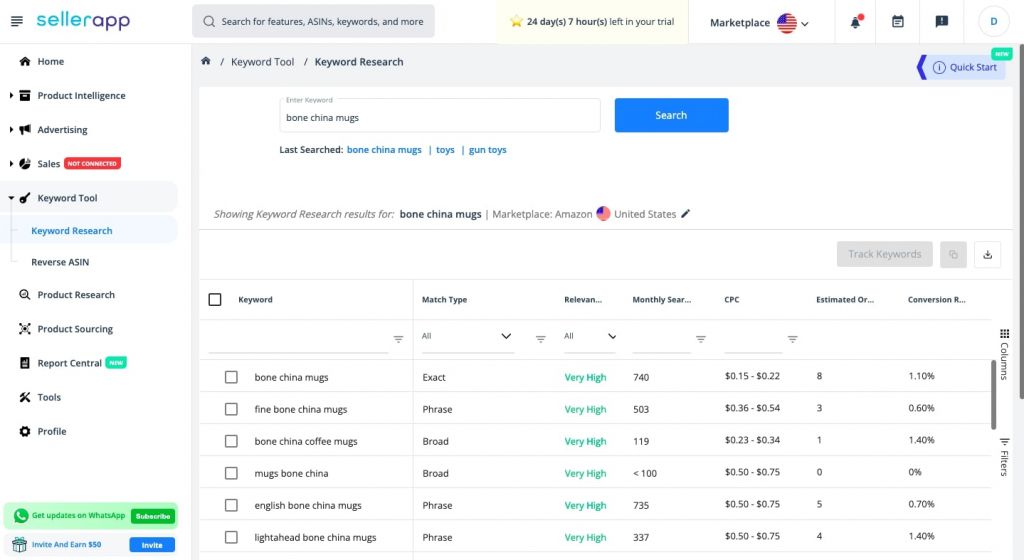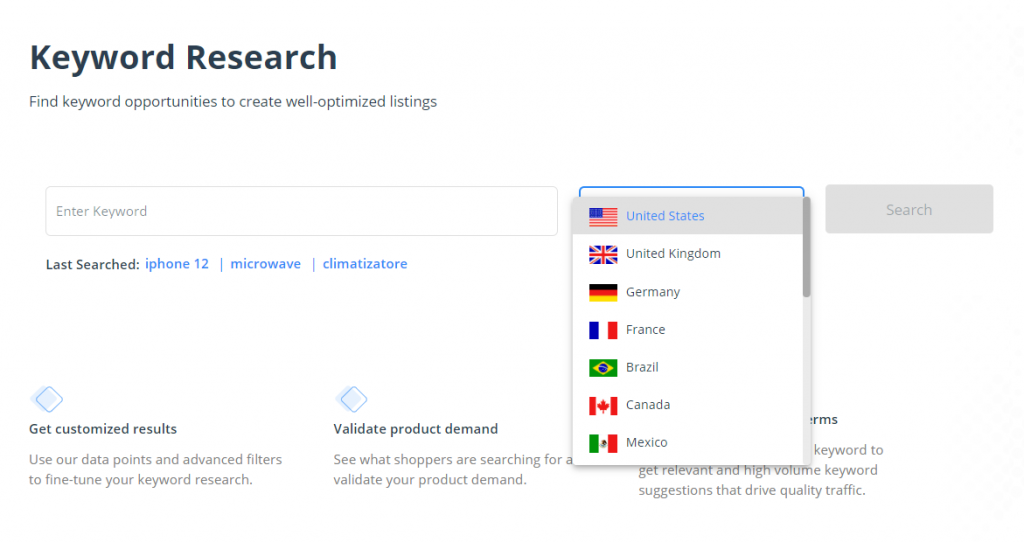Keyword Research – Identifying Effective Keywords.
Amazon keywords are relevant search terms that a customer types into the search bar on Amazon to find a particular product or category. A keyword is what connects a customer to the related product they are searching for.
The right set of keywords can work magic for you. It can bring in loyal customers to your product listing. In this article, we can look at how to filter the best keywords that are relevant to your Amazon product.
Let us follow a step-by-step pattern to understand the process of selecting keywords.
What are the characteristics of a good keyword?
A good keyword would have these qualities.
- It needs to be of high/medium search volume.
- The keyword needs to be relevant to the product.
- It needs to have a longtail attached to them. Longtails are multiple specific phrases that a customer searches for when they are closer to the purchase of a product.
- The keywords need to have a high/medium conversion rate.
- The keyword can also be classified as trending. Although this will help in the overall ranking of the keyword, it is not mandatory for the keyword to be trending.

Match Type
There are 3 main types of keywords and two sub-type keywords you need to know about. Let us explore these different keyword types.
- Exact Match Keyword.
The search term must be the exact match of the keywords you are looking for to add to your ad campaign list. For example, “Baseball Glove” is an exact match keyword. The eligible keywords for this exact match are “Baseball Glove” and “Baseball Gloves. The ineligible keywords include “Gloves for Baseball” “MLB Gloves”.
- Phrase Match Keyword.
The keywords may include the exact phrase or the close variations. Relevant phrase matches can include words before or after the keyword. For example “Red lipstick” is the keyword. The phrase match for this item would be “Best red lipstick” and “Brand of lipstick”. The ineligible match for this can be “Lipstick for make-up”.
- Broad match.
This type of keywords includes all the possible variations to the exact match keyword. It is called broad match since it can connect to a wider variety of search terms. The example for this can be “Kids teddy bear toys”. The eligible broad match for this product can be “teddy bear toys for kids” and “Kids plush teddy bear toy”. The ineligible matches include “kids toys” and “teddy bear toys”.
1. Select 5 to 10 primary keywords


Make a list of 10 – 15 main keywords for your product listing either by going through existing listings on Amazon or by guessing how buyers search for your product on Amazon.
NOTE: In most cases, the former rather than the latter is preferred as the assumption is the existing listings would have already done keyword research at least for their title. If it’s a new niche, then you guess keywords by looking at Google or eBay or just by common sense.
Keyword research from scratch
In the Keyword Research tool on the left-hand menu, type in the seed keyword. And, select the geography of your choice and search for the keywords that your customers resonate with.
This lists the most relevant and highly searched variants of the seed keyword. Export or pick keywords by doing the following –
Step 1 – Manually sort and pick the most relevant keywords
Step 2 – Sort the search volume column and pick the keywords that have high or medium search volume
Step 3 – Sort the conversion rate column. Pick the ones that have a high conversion rate, but keep an eye on the relevance score of the keyword for the product while doing this.
Step 4 – Check out trending keywords to get relevant trending keywords for your product
Step 5 – Make a list of about top 10 or maximum 20 best keywords. Repeat the process for the rest of the 5 to 10 primary keywords.
Keyword research for existing listings on Amazon
For discovering the top sellers, search your main product keyword on Amazon.
Step 1 – Pull out the SellerApp Chrome Extension.
Step 2 – Sort the rows based on Sales/day. Click on Sales/day twice to sort in the descending order.
Step 3 – Copy the ASIN from the best-selling product and paste in the Keyword Research feature on the left-hand menu, change “Keyword” to “ASIN”.
Step 4 – Do an ‘Export to CSV’ to copy all the keywords or copy selected keywords by checking the boxes next to the keywords and click on ‘Copy Keywords’.
Step 5 – Repeat the process for the top 5 sellers.
After combining the keywords together, do the following:
Step 6- Manually sort and pick the most relevant keywords
Step 7 – Sort the search volume column and pick the keywords that have high or medium search volume
Step 8 – Sort the conversion rate column. If conversion rates are good enough, choose the top 20 keywords
Step 9 – Check out trending keywords to get relevant trending keywords for your product
Step 10- Make a list of the top 50 best keywords
Extract Keywords from own listings
Track your product on Seller App and go to Product Keyword feature ASIN > Product Keyword
Step 1 – Export CSV
Step 2 – Add a filter to the first row or the header in the spreadsheet and filter out all the rows where “In Bullet” and “In Title” are “True”.
Step 3 – In the Keywords left, manually sort and pick the most relevant keywords
Step 4 – Sort the search volume column and pick out keywords that have high or medium search volume
Step 5 – Sort the Broad Impressions column. If broad impressions are more than 100 for at least 20 keywords then choose the top 20 keywords
Step 6 – Check out trending keywords to get relevant trending keywords for your product
Step 7 – Make a list of about top 20 best keywords
2. Make a master keyword list
Now combine all the keywords into one master list with about 200 odd keywords.
Segregate them based on search volume into three segments as follows –
- High search volume generic keywords
- High/medium search volume long-tail keywords
- Medium/Low search volume keywords
Now make a list of keywords that describe the product such as:
- Adjectives like soft, sturdy, flexible, odor-free, vegan, pure, natural etc.
- Keywords that describe the demographics like toys for kids, 10-year-old, young girls, etc.
- Synonyms like nail paint, nail polish,
- Lastly occasions it is usually used in – birthday party supplies, gift, handmade etc
Put them all together without duplicates, ensure they are not already in the title, bullet points or no conjunctions like and, but, for, nor, or, so etc
3. Know which keywords go where in the Amazon Product listing
- High search volume generic keywords go to the Title
- High/medium search volume long-tail keywords go to Bullet Points
- Medium/Low search volume keywords either go to description or backend search terms
- And lastly, the keywords randomly put together like the adjectives, attributes, synonyms go into backend search terms
Follow these important steps to turn your listing into a high-powered optimized listing for winning sales and profits in the competitive Amazon market.
Your next step is to create a super converting listing with the keywords shortlisted with the help of this article.
Read more:


